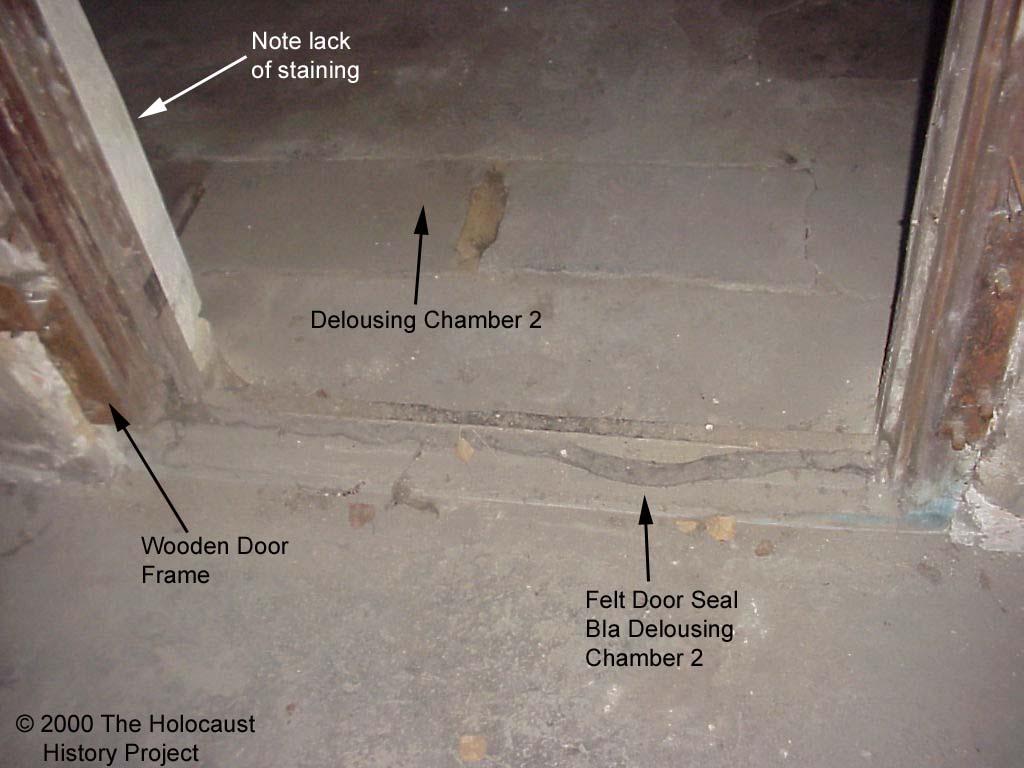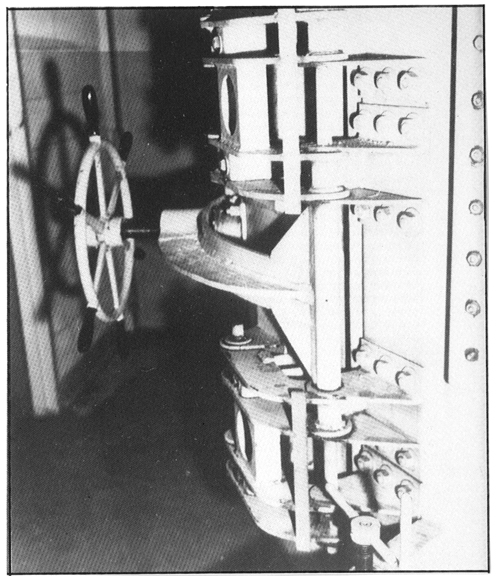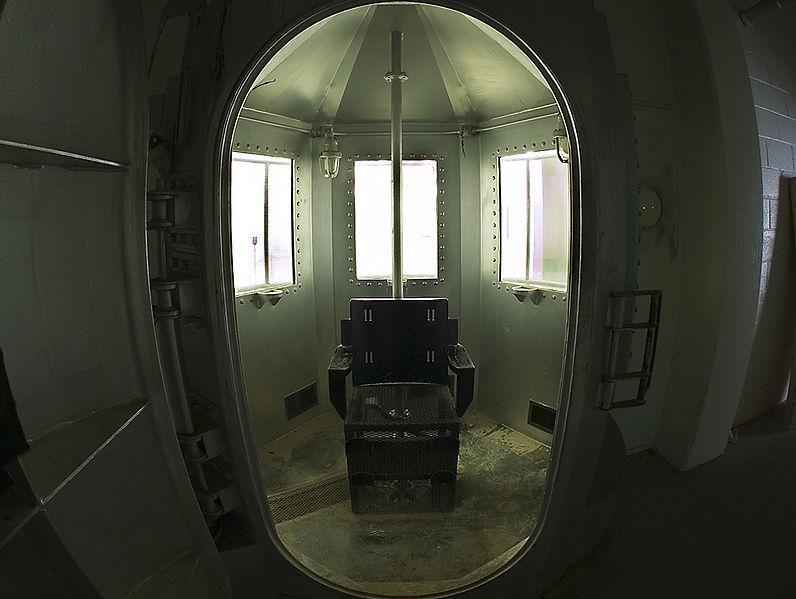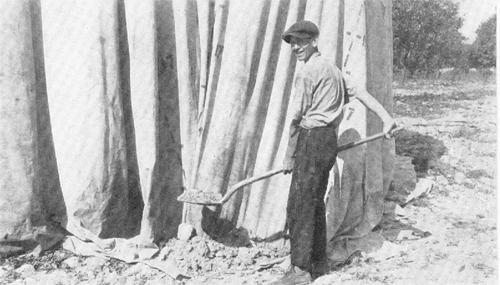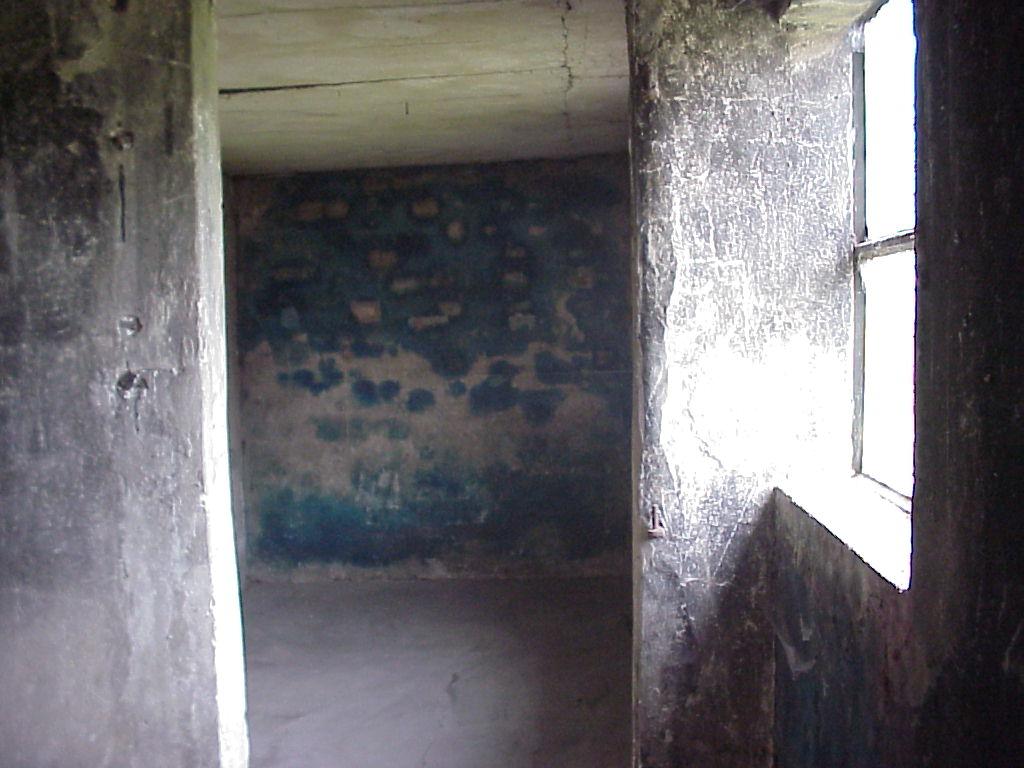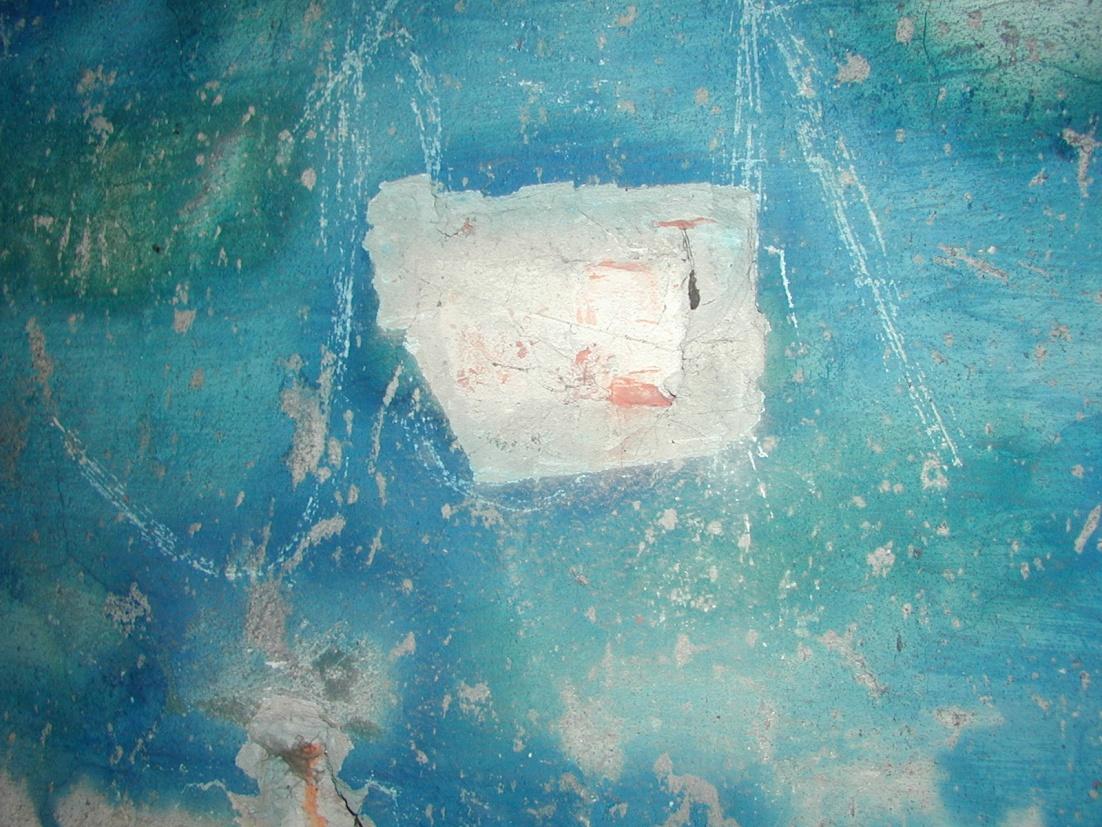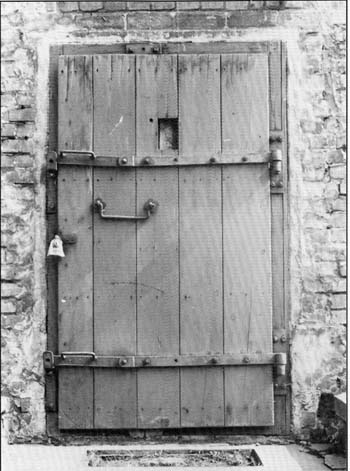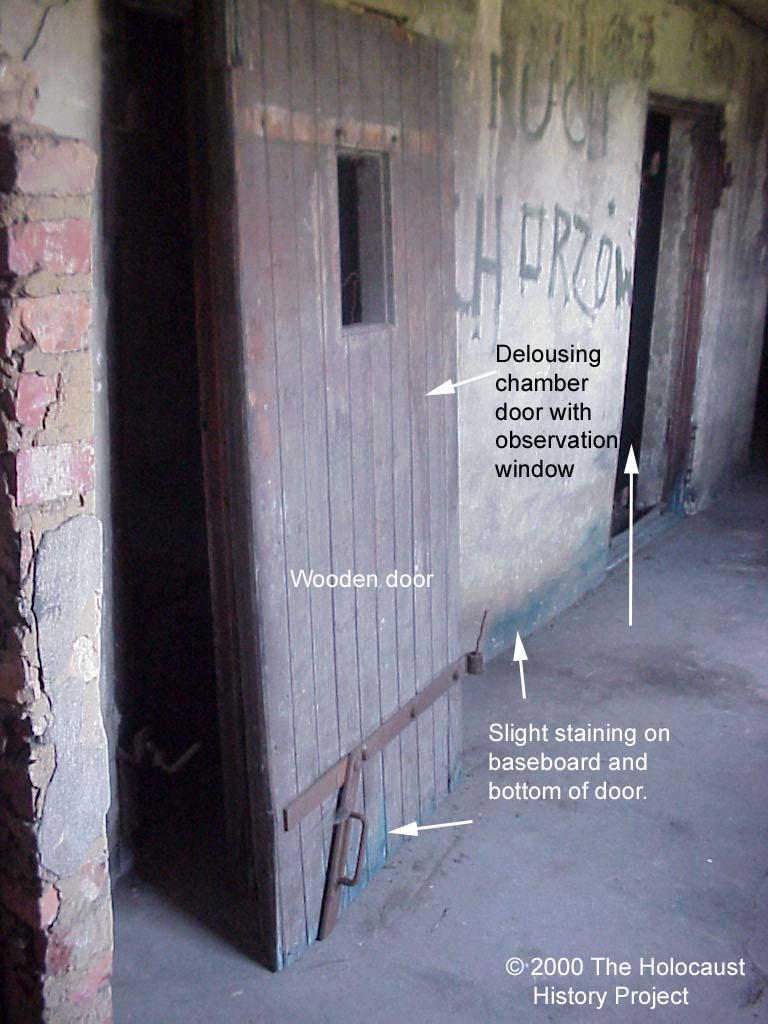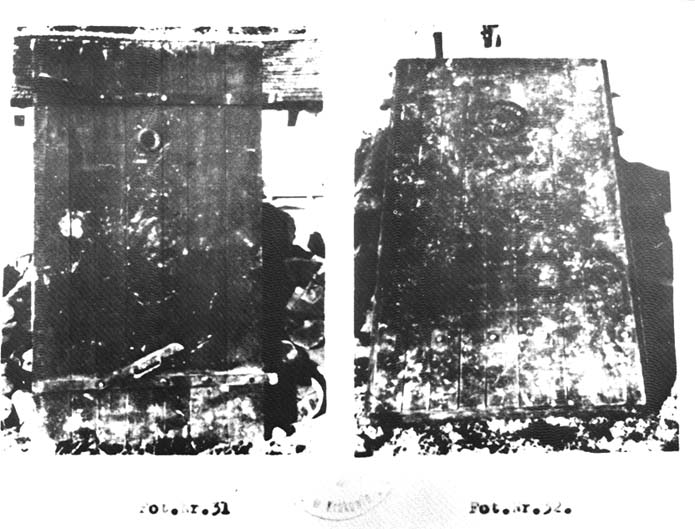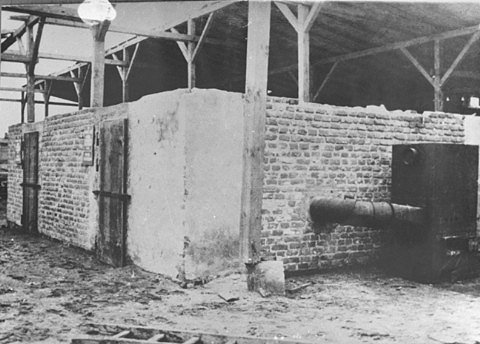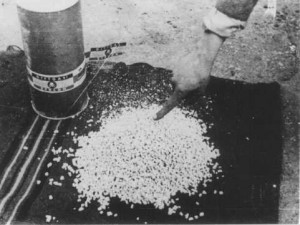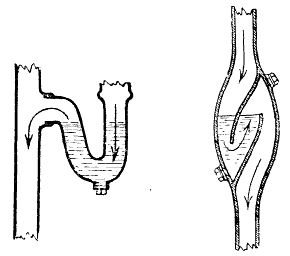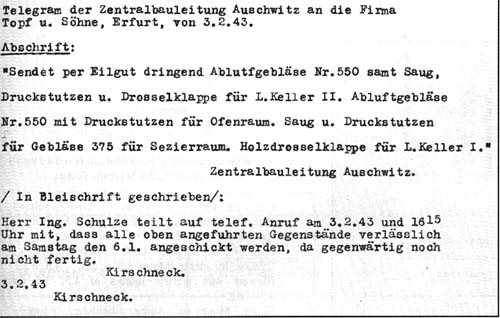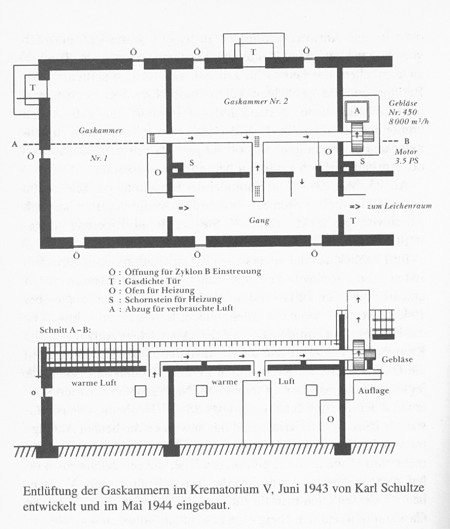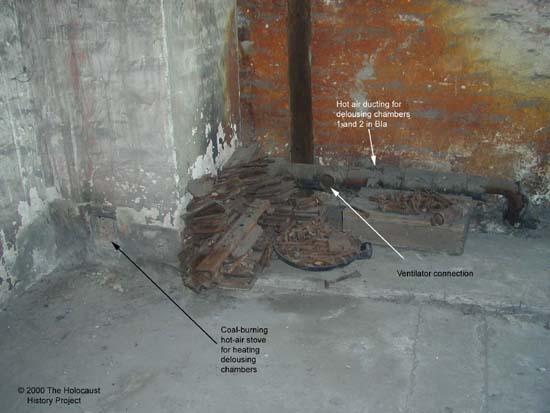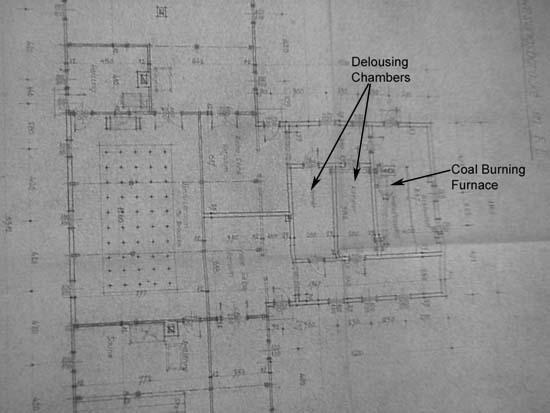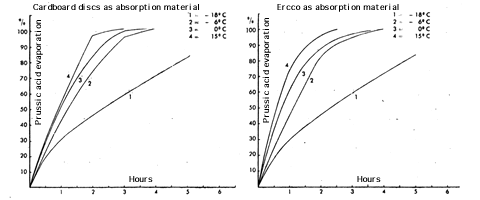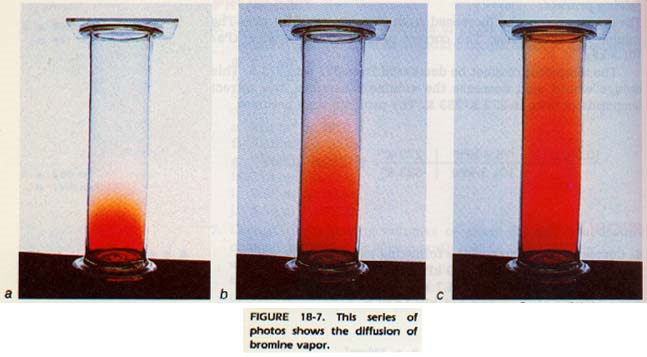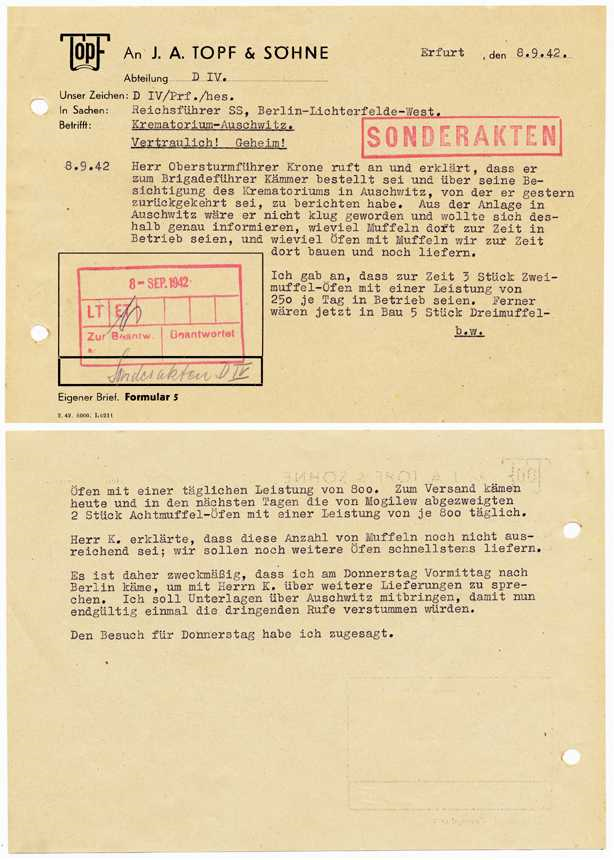 |
 |
A Documented Analysis of the Speech given by Fred A. Leuchter on November 10, 1991
by Harry W. Mazal OBE
On November 10, 1991 in Weinheim, Germany, Fred A Leuchter made a presentation to a group of German right wing extremists. The meeting was chaired by Günter Deckert who acted as Mr. Leuchter�s interpreter, 1 and infrequently added comments of his own.
Mr. Leuchter�s words were centered on what he refers to as "The Gas Chamber Myth" and to his complaints on what he calls "My Persecution by the Jews." Both a video-taped presentation of Mr. Leuchter�s talk and its translation by Mr. Deckert were used as documents in evidence at a trial by the State Court of Mannheim under Germany�s laws concerning incitement to hatred against a minority of the population. (Volksverhetzung).
It is not the purpose of this paper to analyze or criticize the laws in Germany � or elsewhere � that relate to freedom of speech issues as they have been more than adequately discussed elsewhere.2 Nor will this paper analyze Mr. Leuchter�s bizarre and paranoid views in his section entitled: "My Persecution by the Jews." Perhaps this can be done in the future, but our main mission is dealing with Holocaust denial, not the misguided babblings of a professed antisemite.
The purpose of this paper is to address the many inconsistencies, misinterpretations, and mendacious statements made by Mr. Leuchter. The complete text of his speech appears as Appendix I of this document. Pertinent statements made by Mr. Leuchter will be subjected to careful analysis and comment with relevant end notes appended in every case.
To facilitate this process, every statement made by Mr. Leuchter and subjected to analysis will be highlighted in this response in bold italics as well as in the original document (Appendix 1), while the commentary will appear in plain text.
Note: Much of the material in this analysis has been taken from an unpublished manuscript by the author.3
Mr. Leuchter�s first words are false and misleading:
Background:
"Fred A. Leuchter, Jr. is an American engineer�"
This is certainly not so. Mr. Leuchter is not now nor has he ever been an engineer; he has never studied engineering nor obtained a degree in engineering in any institute of higher education. He was not then nor is he now licensed to practice any form of engineering in any part of the United States.4 His claims will be further addressed in the body of this paper. Suffice it to say at this moment that when this was discovered, he was totally discredited and is no longer involved in the business of providing materials or advice on executions.
Beginning with the State of Missouri, whose replacement Lethal Gas Chamber Fred A. Leuchter was tasked with designing and constructing �
"�Missouri does not have an operational gas chamber to this day even though Leuchter had allegedly designed one for them �"5
"Fred A. Leuchter has consulted with a number of other states on functional hardware and safety equipment."
The following are some of the comments made by various state authorities regarding consultations with those states. The comments (below) were made by those authorities. They suggest that Mr. Leuchter�s claims are specious and fraudulent:
"I can inform you, however, that San Quentin has not contracted with Fred A. Leuchter, Jr. for the installation of a heart monitoring system or for any other work." Signed: DANIEL B. Vasquez, Warden (California)
and,
"I discussed your request with Mr. Nathan A. Rice, Former Warden, and he stated that he vaguely recalled a telephone conversation between him and a gentleman professing to be an expert on execution chambers. Mr. Rice further states that the gentleman called him for the purpose of selling a lethal injection machine...
Also, our records do not support that Mr. Leuchter performed either consulting or any service...I can attest that the planning and work was performed by the Department of Correction Engineering Section and our institution maintenance department." Signed: Gary T. Dixon, Warden (North Carolina) 6
"In 1978 he was asked by a U. S. prison system to evaluate the condition of an electric chair to determine if it was suitable for future use."
The following statements further place Mr. Leuchter�s claims in doubt. They suggest that he has attempted to extort those facilities that would not place contracts with him.
On July 20, 1990, Alabama Assistant Attorney General Ed Carnes sent a memo to all capital-punishment states questioning Leuchter's credentials and credibility. Carnes stated that not only were Leuchter's views on the gas-chamber process 'unorthodox' but that he was running a shakedown scheme. If a state refused to use his services, Leuchter would testify at the last minute on behalf of the inmate, claiming that the state's gas chamber might malfunction. [Memorandum from Ed Carnes, Alabama Assistant Attorney General, to all Capital Punishment States July 20,1990; Shapiro 'Truth Prevails' pp. 17 and 21; Newsweek, Oct. 22, 1990, p. 64; Swampscott Journal, Nov. 1, 1990.] According to Carnes, Leuchter made 'money on both sides of the fence.' [Associated Press, October 24, 1990.] Describing Leuchter's behavior in Virginia, Florida, and Alabama, Carnes observed that in less than thirty days Leuchter had testified in three states that their electric-chair technology was too old and unreliable to be used. In Florida and Virginia the federal courts had rejected Leuchter's testimony as unreliable. In Florida the court had found that Leuchter had 'misquoted the statements' contained in an important affidavit and had 'inaccurately surmised' a crucial premise of his conclusion [Carnes, Op. Cit., 2.] In Virginia, Leuchter provided a death-row inmate's attorney with an affidavit claiming the electric chair would fail. The Virginia court decided the credibility of Leuchter's affidavit was limited because Leuchter was "the refused contractor who bid to replace the electrodes in the Virginia chair [Shapiro, "Truth Prevails, 22]." (Lipstadt, 170)7
"Beginning with the State of Missouri, whose replacement Lethal Gas Chamber Fred A. Leuchter was tasked with designing and constructing, Fred A. Leuchter has consulted with a number of other states on functional hardware and safety equipment."
Only one of the wardens of the various state penitentiaries appears to have had anything positive to say about Mr. Leuchter. Mr. Bill M. Armontrout, who at that time was Warden of the Missouri State Penitentiary (1984-1990). He was also a witness on April 19, 1988 at the so called "Second Zündel Trial."8 In response to a question from Mr. Douglas Christie, Zündel's defense attorney, Mr. Armontrout testified that there was only one consultant in the United States that he knew in the design, operation and maintenance of gas chambers. That consultant was Fred Leuchter.9 Leuchter's pamphlet "The Leuchter Report: The End of a Myth" incorporates a letter of recommendation issued by Warden Armontrout.10 What is rather remarkable about Warden Armontrout's recommendation and his subsequent testimony at the Zündel trial is the fact that the gas chambers in that prison were built in 1938 and ceased operations in 1965. Mr. Leuchter was attending Boston College and studying history at that time. A letter has been sent to Mr. George Lombardi, current Director of the Missouri Department of Corrections with a request to clarify the relationship between Mr. Armontrout and Mr. Leuchter.11
"Fred A. Leuchter, Jr. is the recognized worldwide expert on execution procedures and hardware, which include Electrocution, Lethal Injection, Lethal Gas and Hanging." 12 [�]"It is because of this expertise that Fred A. Leuchter was asked to investigate the alleged gas execution facilities in Poland."
In 1988 Ernst Zündel paid Mr. Leuchter $30,00013 plus expenses to travel to Auschwitz and seek out evidence that might create doubts about the gas chambers which were used to murder hundreds of thousands of innocent people. While in the concentration camp and without permission from the authorities, Mr. Leuchter broke into a building, defaced the walls of various sites and removed samples. These criminal activities will be described in detail in the body of this paper.
"In January of 1988, although an expert on Execution Technology, I knew nothing about the alleged execution gas chambers allegedly operated by the Nazis for the alleged extermination of Jews and others, in Poland. � I assumed they worked, and were worked. I did not expect the shocked surprise that awaited me."
Mr. Leuchter claimed to be a "� recognized worldwide expert on executions and hardware �" yet he had apparently never looked at the documentation on the gas chambers that were employed in a many places in Europe. These include the Aktion T-4 sites such as Brandenburg, Grafeneck, Hartheim, Sonnenstein, Bernburg, and Hadamar.14 With Hitler�s knowledge and approval, these sites were utilized to murder mentally ill and physically disabled persons.15
It also does not appear that Mr. Leuchter had studied the vast number of documents related to the lethal gas chambers utilized both in mobile gas vans16 and in the more infamous camps such as Belzec, Sobibor, Treblinka, Majdanek and Auschwitz17 before he embarked on his fact-finding trip on behalf of Mr. Zündel.
"At the [Zündel] trial, the court dismissed Leuchter and his 'findings' as inadequate. The judge stated that 'His [Leuchter�s] opinion on this report is that there were never any gassings or there was never any exterminations carried on in this facility. As far as I am concerned, from what I've heard, he is not capable of giving that opinion. He is not in a position to say, as he said so sweepingly in this report, what could not have been carried on in these facilities.��18
Barbara Kulaszka, one of Ernst Zündel's Canadian lawyers in his trial held in 1988, and a Holocaust denier in her own right, confirms what Judge Thomas had to say about Leuchter's expertise as a specialist in gas chambers and crematories:
[Judge Ron] �Thomas stated that Leuchter's opinion in the report was that there were never any gassings or exterminations carried on in the facilities. He held that Leuchter was not capable of giving that opinion. (32-9049), nor was he capable of testifying regarding the results of the analysis of the samples. His testimony was restricted to the taking of the samples and to whom he turned them over. (32-9047, 9048) Leuchter was allowed to testify with respect to his own work, his observations of the camps and the information he had gathered concerning the facilities, and whether the facilities were feasible as gas chambers. (32-9054) Defence counsel was instructed not to refer to the Leuchter Report during the in-chief examination. Thomas held that Leuchter had no expertise whatsoever in crematories and disallowed any testimony relating to crematories. (32-9052, 9054)]�19
Mr. Leuchter continues with another unsubstantiated claim:
"After a long search for a great number of years Dr. Robert Faurisson, the world�s greatest gas chamber expert, then, now and ever, had been directed to me, as the man who understood the technology and consulted with those states in the United States utilizing gas as the procedure for execution."
Professor Faurisson (born 1929) is a French academic who received a State Doctorate at the University of Sorbonne in 1972. His last position between 1973 and 1990 was as a tenured Professor of 20th century/Contemporary French literature at the University of Lyon.20 He claims that he was removed from his university chair in 1991. He was later cited for violations of the Gayssott Act.21 22 His claims were rejected by the Human Rights Committee of the United Nations in 1996.23
Professor Faurisson�s academic training is limited to the study of French literature. It does not include the study of engineering, physical chemistry, human respiratory physiology, physics or chemistry, all of which are at least useful, if not indispensable, to become a so-called ��gas chamber expert�� He is certainly no better prepared academically to comment on the subject of lethal gas chambers than is Mr. Leuchter. Lacking any academic qualifications or experience in the design and use of gas chambers, Prof. Faurisson can scarcely be considered ��then, now and ever��as �the world�s greatest gas chamber expert.�
Professor Faurisson�s credibility and objectivity is further placed in in doubt when he is clearly identified as a Holocaust denier with deeply rooted anti-Semitic beliefs:
"Zionist power stems from the West's belief in the 'Holocaust' myth....The Jews do not tolerate any questioning of the "Holocaust". Against the revisionists they use physical violence and judicial repression because, on the level of historical and scientific argumentation, they have been defeated hands down by the revisionists. We have been able to expose their lies, one by one. Therefore Jews and Zionists seek refuge in violence and intimidation. They treat revisionists like Palestinians ... The more those in the West believe in the "Holocaust", the more Moslems they will kill and cause to be killed in Palestine, in Afghanistan, in Iraq or elsewhere."24 25
Mr. Leuchter continues:
"Further, design and construction analysis shows that these facilities could never have operated as gas chambers. Even if, as some have suggested, safety was not a consideration, some minimal gas operation requirements would have bad to have been met, certainly for the physical handling of Zyklon B. All of the fumigation chambers were properly designed, both from a safety standpoint, as well as from a functional one."
Mr. Leuchter is quite mistaken. As shall be seen in subsequent paragraphs, any enclosed space can be readily and safely employed as a lethal death chamber; even a broom closet. This paper will demonstrate graphically how truly minimal the operation requirements are for handling hydrogen cyanide or its commercial presentation, Zyklon B, whether these be used for fumigation or extermination.
He also refers to the "fumigation chambers" employed in the Birkenau facility, assuring his listeners that these "�were properly designed�" If this is so, then Mr. Leuchter has missed the main point of his argument against the use of hydrogen cyanide in gas chambers designed for killing human beings. To wit:
The fumigating chambers in the disinfestation facilities in Birkenau are extremely primitive constructions. They are located, and are still standing, in sections B1a and B1b of the camp. Both of these facilities were used to delouse clothing and bedding employing concentrations of the poison gas that were several hundred times higher than would have been necessary to kill all mammals, including human beings. In spite of the high lethal concentrations of hydrogen cyanide used to kill lice, these fumigating chambers only used simple felt strips (Illustrations 126 and 227) rather than rubber gaskets to seal the doors, used wooden doors rather than the submarine-styled steel doors installed in lethal gas chambers designed to execute criminals in the United States (Illustrations 328xxviii and 429), and they vented the gases to the atmosphere without the need for tall exhaust chimneys when a gassing was over (Illustration 530). Inasmuch as these two facilities were in constant use for their designed purpose, it can be assumed that they were safe enough for employing very much higher concentrations of hydrogen cyanide gas and for much longer periods of time than would have been needed to kill human beings. Mr. Leuchter�s comments about "minimal gas operation requirements" are therefore greatly overstated and untenable.
![]()
![]()
Illustration 1
Felt seal gasket on the door frame of delousing chamber 2 in B1a
![]()
![]()
Illustration 2
Felt seal gasket on the door frame of delousing chamber 2 in B1a
![]()
![]()
Illustration 3
![]()
![]()
Illustration 4
Homicidal gas chambers employed in (Illustration 3) Missouri Department of Corrections and (Illustration 4) the State Prison of New Mexico
![]()
![]()
Illustration 5
North-to-South view of the building housing two gas chambers for delousing clothing and bedding. The chambers are located immediately behind the three windows. Note that there are no high stacks or chimneys to dispose of the hydrogen cyanide gas once the delousing process is over.
"The facilities I investigated, known to the world as Krema I, located at Auschwitz, the Main Camp, Kremas II, III, IV, V and Delousing Facility Number 1, located at Birkenau, Auschwitz 2 and Bad and Desinfektion I, located at Majdanek, Lublin, Poland [�] none of these facilities exhibit any of the necessary characteristics which would enable them to operate, or to have operated, even marginally or unsafely, as gas execution chambers."
Mr. Leuchter insists that none of the facilities named above were suitable for murdering people. To reiterate our position on this matter, any enclosed space can be used as a gas chamber. It must be pointed out that several decades before gas chambers were employed to execute criminals, hydrogen cyanide gas was being used in very high concentrations for a wide variety of fumigations. All of these were undertaken without any of the extraordinary and unnecessarily elaborate precautions that were adopted by the various penal institutions in the United States. This point will also be addressed in the body of this paper.
A review of Mr. Leuchter�s false statement on the �facilities� makes it necessary to touch on several aspects:
A. Use and Toxicity of Hydrogen Cyanide
Hydrogen cyanide was first employed as an agricultural fumigant in 1886. It has since been used "� on a large scale both for the destruction of rats on board ship and also for vermin and other insect pests of all kinds in flour mills, factories, warehouses, cold stores, greenhouses, etc.� 31 The concentration of hydrogen cyanide gas � up to 16g/m3 32 - employed for these purposes is several orders of magnitude higher than that which is necessary to kill human beings: A concentration of 3,404 ppm [3100 mg/m3] will result in the immediate death of all warm-blooded animals including humans, 2000 ppm [1,820 mg/m3] within one minute, whereas even much lower concentrations of 270 ppm [246mg/m3] are fatal after 6 to 8 minutes, 181 ppm [1650mg/m3] after 10 minutes, and 135 ppm [123mg/m3] after 30 minutes. The LC50 for hydrogen cyanide (the concentration or dose that is lethal to 50% of the exposed population is 100-300 parts per million) 33
Dr. Richard Green points out the fact that higher concentrations than the minimums stated above are rarely used and that higher concentrations have several advantages: In his Expert Witness Report presented as evidence agains David Irving in his failed libel lawsuit against Professor Deborah Lipstadt he states:
The fact that 300 ppm of HCN is rapidly lethal to human beings does not actually prove that such small concentrations were used in the homicidal gas chambers. The advantage of using a higher concentration is twofold: 1) the lethal effects can take place faster, and 2) the lethal concentration can be established much faster. The advantage of using a lower concentration, of course, is that it would save money. I have not seen evidence that the concentrations actually used for murder were significantly less (i.e., more than a factor of 2 or 3) than those used for delousing. 34
This is demonstrated in the graph that Dr. Green included in his Expert Witness Report:
![]()
![]()
Variation in outgassing times and time that chambers would be exposed to different exposure limits under different scenarios for total HCN used.
For the 12 months ending on June 30, 1922, 1,347 ships were fumigated in New York with hydrogen cyanide.35 By 1927 over 1000 ships had been fumigated in English or Welsh ports alone using hydrogen cyanide.36 None of the elaborate precautions employed in the gas chambers to execute criminals, as proposed by Mr. Leuchter, were ever required or necessary.
B. Proper Sealing of the Gas Chambers
Mr. Leuchter remarks on the complex and heroic systems used to seal the various homicidal gas chambers installed in various American prisons. He relies heavily on the design and construction of those gas chambers as evidence that much simpler enclosed places were neither adequate for homicidal purposes, nor safe for the operators of the facilities. He either ignores the traditional methods employed for sealing spaces subjected to fumigation with hydrogen cyanide at concentrations considerably higher than needed to kill humans, or purposely conceals this information, which is readily available in any public library. Some examples follow: [Emphasis by the author]
The Food and Agriculture Organization of the United Nations makes the following recommendations for space fumigation:
"The term 'space fumigation' is convenient for the designation of a wide range of treatments in enclosed spaces, which either contains infested materials or residual insect populations.
Sealing Methods and Materials
Since sealing techniques are common to all types of fumigation, these are outlined first. In practice, the choice of materials is largely influenced by their availability.
Narrow Cracks and Small Holes
Masking tape, heavy Kraft paper applied with flour paste, caulking compound, paint-on adhesives, [�] etc. may be used to cover or seal small cracks and holes. [�]
Larger Cracks, Crevices and Openings
Heavy Kraft paper applied with flour paste and impregnated with heavy grease or [�] sealed with masking tape may be used for larger openings."37
"Fumigation Methods" published in 1902 recommends:
"3. The building should be made practically gas tight by closing up all the cracks and external openings. This can be done best by pasting strips of ordinary paper over the cracks. Special attention should be given to windows and doors, and they should be thoroughly secured before the gas is generated."38
The "Monthly Bulletin of the Division of Zoology" published in 1908 recommends the following for household fumigation:
"See that all doors are closed tightly, and if there be loose cracks fill them with paper, or better with wet strips of paper, and pat them over the cracks with the hands so as to make doors and windows airtight, to prevent ventilation when it is not wanted." 39
The "Preliminary Report on the use of Hydrogen Cyanide for Fumigation Purposes" recommends the following for the fumigation of ships:
"The intention is to render the parts of the ship which have to be fumigated as air tight as possible. Ventilators must be closed by canvas or other means and hatches battened down, and hatch covers carefully adjusted. Ports must be closed or papered over, and doors leading to the open deck should be pasted up but not locked."40
Dr. Asa C. Chandler recommends the following precautions for fumigating homes with hydrogen cyanide:
"Make the room or house as near air tight as possible, stopping all the large openings such as fireplaces and chimney flumes with old rags or blankets. Seal cracks about windows and doors with strips of wet newspaper. Such strips when thoroughly wet can be applied quickly and effectively over cracks and will stick tightly for several hours, and can be removed easily after the operation." 41
Monsanto (American Cyanamid and Chemical Corporation), the U.S. licensee for the manufacture and distribution of Zyklon B, a commercial form of hydrogen cyanide, issues the following instructions for sealing military barracks in preparation for fumigation:
"If window sashes are loose, they should be wedged with wood wedges inserted finger-tight. If upper sash is loose insert wedge on outer lower part of sash, forcing sash against window stop. Wedge the lower sash on the inside near the juncture of the two sashes. If juncture of upper and lower sash then is not tight, it should be sealed with gummed paper tape or Scotch tape. Seal each end of the junction of the sash with wads of torn up, damp newspaper, finger-tight. Screened vents in second story ceilings may be sealed by setting the wooden covers in place in the vents, then closing the vent screens over pieces of heavy Kraft paper cut somewhat larger than to size. Roof ventilators and "attic" louvers should be sealed, the ventilators with 84" wide heavy Kraft paper tied around the pipe below the cap. Louvers should be sealed from the outside with paper, ply-board, or tar paper held in place with strips of wood similar to lath. All ceiling vents should be closed, unless insects are suspected of being present in the attic, in which case they should be left open.
"All doors should be sealed on the inside, except exit door, which should be sealed from the outside. Before each door is sealed, lock it or nail it on the outside, so it can be opened from outside."42
The New York State Agricultural Experiment Station describes the use of tents for fumigating pear trees:
"The fumigating tents were manufactured in California especially for this purpose. Most of these were of 8-ounce duck"
[Note: "duck cloth" is a cotton material also known as "canvas." It is a closely woven cotton cloth classified according to weight with grade 1 being the heaviest and 12 the lightest.43
"Fumigating tents are marked so that the proper dosage of gas may be readily determined."44 Illustration 6 shows a number of such tents awaiting fumigation with hydrogen cyanide. The tents are weighted down with dirt prior to getting charged with hydrogen cyanide gas (Illustration 7)
![]()
![]()
Illustration 6
![]()
![]()
Illustration 7
Illustrations 6 and 7: Canvas fumigating tents are sealed with piled dirt around the base
"Disinfection Facility Number 1, at Birkenau, was forensically examined to provide a control for the other forensic samples taken. Since the climate, exposure, and storage conditions for all the samples were essentially the same, with the exception of Kremas IV and V, for almost fifty years, and the brick and mortar being chemically the same in all cases",
Mr. Leuchter�s sampling methodology is seriously flawed. He does not employ a double-blind sampling technique45 � which already makes any sample taking immediately suspect � and he either ignores or chooses not to mention that the walls in the different sites are made of different materials and have received various treatment processes. Some walls are bare concrete; others are whitewashed concrete; while others have a thick plaster coating covering brick walls, etc. Presumably every variant of those walls should react differently to the same concentration of hydrogen cyanide, but Mr. Leuchter does not touch on this. Proper analytical techniques also demand that all the samples be of a uniform size and depth, and that they be taken randomly from all of the walls in the same enclosed spaces. Mr. Leuchter simply chips away with a hammer and chisel, or removes entire bricks from the walls with no regard for proper and representative sampling. All of these activities were made furtively and illegally forcing Mr. Leuchter to act hastily.
Because hydrogen cyanide is a gas46 it is presumed that the concentration of cyanide in all of the walls, floor and ceiling in any particular space will be nearly identical. Mr. Leuchter does not appear to acknowledge this in his study.
Some of the samples reported by Mr. Leuchter as having shown high concentrations of cyanide were taken from walls in areas that were in rooms that were totally outside of the delousing chambers where hydrogen cyanide was employed to delouse clothing. Some of the walls inside the building are removed from the delousing chambers by several meters. They have large, albeit random, blue stains that are possibly Prussian blue, a hydrogen cyanide derivative [Illustration 8]. It remains for Mr. Leuchter and other Holocaust deniers to explain how such high concentrations of cyanide were found in areas where there were open coal fires, and, more important, staff and prisoners walking around. He must also explain why only some of the walls in these rooms and passageways and none of the ceilings show these stains, and also why these stains are not uniform in nature, as would be expected if a gas was responsible for making them.
![]()
![]()
Illustration 8
Illustration 8 shows a small room located next to one of the delousing chambers in B1a. The wall furthest from the delousing chamber shows a large number of random blue stains that are presumably Prussian blue, a cyanide derivative.
Considerably more serious is that Mr. Leuchter chooses to ignore the statements made by James Roth PhD, Laboratory Manager of Alpha Analytical Laboratories47 where the samples he took from Auschwitz and Birkenau were submitted for analysis. In a filmed interview in which Mr. Leuchter also appears, Dr. Roth makes the following damning statement:
"I don't think the Leuchter results have any meaning. There's nothing in any of our data that says those surfaces were exposed or not. [�]
"He presented us with rock samples anywhere from the size of your thumb up to half the size of your fist. We broke them up with a hammer so that we could get a sub-sample; we placed it in a flask, add concentrated sulfuric acid. It undergoes a reaction that produces a red-colored solution. It is the intensity of this red color that we can relate with cyanide concentration.
"You have to look at what happens to cyanide when it reacts with a wall. Where does it go? How far does it go? Cyanide is a surface reaction. It's probably not going to penetrate more than 10 microns. Human hair is 100 microns in diameter. Crush this sample up, I have just diluted that sample 10,000; 100,000 times. If you're going to go look for it, you're going to look on the surface only. There's no reason to go deep, because it's not going to be there. Which was the exposed surface? I didn't even have any idea. That's like analyzing paint on a wall by analyzing the timber that's behind it. If they go in with blinders on, they will see what they want to see. What was he really trying to do? What was he trying to prove?�48
Illustration 9 below demonstrates graphically what Dr. Roth explained above. A heavy layer of plaster covers a brick wall. The blue pigment, ostensibly Prussian blue, only covers the surface of the plaster in the same manner that a coat of paint would. The plaster underneath the blue stain is white and the brick is red. To be accurate, any analysis for cyanide that is made of these stains should be limited to the blue coating on the wall. By taking a sample consisting of both the plaster and the blue stain, the cyanide content is enormously diluted and any results thus obtained are greatly understated.
![]()
![]()
Illustration 9
It should be clear that Mr. Leuchter�s unscientific sampling techniques coupled with the methodologies that he employed for analyzing the samples are totally unreliable.
"Fumigation design techniques were also available at the time, but none were ever utilized in the alleged gas chambers".
Fumigation design techniques are perfectly adequate for being used in homicidal gas chambers. In both applications the lethal gas must be contained in an enclosed space, sealed sufficiently to avoid or reduce leaking, allowing the lethal gas to remain in the chamber at an optimum concentration for as long as is necessary. The system for clearing out the gas afterwards can be passive, i.e. opening doors, windows, hatches, etc., or active, i.e. employing forced ventilation. In either case the gas is expelled harmlessly into the atmosphere.
It is important to insist that, if anything, fumigating chambers of any sort pose a much greater threat to the operators and public than do homicidal chambers due to the much higher concentrations of hydrogen cyanide and the much longer period of time required to kill insects. Yet these methods were routinely and safely employed in thousands of cases in buildings, barracks, homes, ships, railway cars, and even fumigating tents.49
"The alleged gas chambers were brick and mortar structures which show no evidence [�]of any sealant usage, which would result in hydrocyanic acid being trapped in the brick and mortar, becoming a lethal problem for workers, for hours.
The existing delousing or fumigation chambers in Birkenau in sections B1a and B1b are also brick and mortar structures with concrete floors. There is no need for any "sealant usage" because hydrogen cyanide is a gas that obeys the gas laws. If it were so that "hydrocyanic acid [would be] trapped in the brick and mortar, this would have posed a considerably greater problem in the delousing chambers where much higher concentrations of gas were employed to kill insects.
Because of its high volatility, hydrogen cyanide dissipates quickly and leaves little or no residue. These characteristics are precisely why it is used to fumigate food products such as flour50, groundnuts (peanuts)51, fruits and other foods.52 Clearly Mr. Leuchter�s claims about hydrogen cyanide "becoming a lethal problem for workers, for hours" are grossly exaggerated.
"No gaskets were utilized on doors, despite what some would have us believe, and in some cases no doors at all were utilized which would allow explosive gas into the crematories."
The question of "gaskets" or door seals has been exhaustively discussed above. If anything, the sort of seals used in the lethal gas chambers and in the fumigation or delousing chambers in Auschwitz and Birkenau were considerably more effective than those described above in the section above entitled "B. Proper Sealing of the Gas Chambers".
Furthermore he offers no evidence to prove that doors were not fixed to the gas chambers. Every description of the gas chambers made both by the perpetrators and the Sonderkommandos clearly mentions that doors were installed on each gas chamber. The gas tight door of the delousing chamber in Block I, of the Stammlager in Auschwitz53 is described as follows: "Gas-tight door of the gas chamber, of conventional design (made by the DAW) with its peephole and two locking bars, each of which fitted into a metal catch through which a threaded rod, bent to form a handle, was screwed, completely blocking the latch and ensuring that the door was tightly closed." [Illustration 10]. The doors used in the delousing chambers of B1a are of similar design 54 [Illustration 11]. A photograph taken from the Zentral Sauna in April 1943 by SS Sergeant Kaman, shows the door to the gas chamber on the south side of Krematorium V.55[Illustration 12]. Door found in the storage area in Auschwitz that was probably used in a homicidal gas chamber.56 [Illustrations 13a and 13b] The doors used in Auschwitz and Birkenau are remarkably similar to those used in the gas chambers of Majdanek shortly after the liberation of the camp and before extensive reconstruction took place.57 [Illustration 14]
![]()
![]()
Illustration 10
![]()
![]()
Illustration 11
Gas tight doors employed in the delousing chambers of [10] Block 1 of Stammlager Auschwitz and in the two delousing chambers [11] in B1a in Birkenau
![]()
![]()
Illustration 12
Gas tight door on the homicidal gas chamber of Krematorium V in Birkenau. The lower building on the left is the gas chamber proper; the door is located on the right hand side.
![]()
![]()
Illustrations 13a (31) and 13b (32)
Gas tight doors stored in the Bauhauf of the Auschwitz camp.
"Two photographs accompanying the report drawn up by Judge Jan Sohn in volume 11 of the Hoess trial, on the "nature of the devices and installations" showing the exterior (31) and the interior (32) of a gas-tight door found in the Bauhof (place where construction materials for the Auschwitz camp were kept). The heavy hemispherical grid protecting the inside of the peephole makes it reasonable to conclude a homicidal use.�58
![]()
![]()
Illustration 14
Gas tight doors used in the homicidal and delousing gas chambers in the Majdanek concentration camp.
"Zyklon B pellets were allegedly scattered on the floor, gas concentrations at the pellets would be more than 99%, much greater than the 6% required for an explosion".
This statement is not correct. The very same technique for scattering Zyklon B pellets on the floor in the homicidal gas chambers was safely used in the various delousing chambers in Auschwitz, Birkenau and Majdanek. Zyklon B pellets were also spread in exactly the same manner when being used for fumigating purposes in thousands of legitimate applications in concentrations considerably higher than are used to murder people.
One report dealing with the use of Zyklon B in the holds of ships states: "A series of tests was undertaken to determine whether it would be practical and safe to leave the residue in the holds following fumigation, which would permit of a better distribution and avoid the necessity of placing the fumigant within a restricted space, as on a piece of canvas. [�] [Illustration 15] In these tests, both on shipboard and ashore, Zyklon-B was scattered in such a manner as to allow the floor to be easily seen through the residue."59 No explosions have ever been reported nor would it be possible for an explosion to occur at the concentrations that are employed.
The statement that "�gas concentrations at the pellets would be more than 99%..." demonstrates that Mr. Leuchter is either unaware of the Kinetic-Molecular Theory of Matter, or that he has chosen to ignore it. Without entering into mathematical formulas suffice it to state that: (a) Gases do not have a definite shape or a definite volume. They completely fill any container in which they are enclosed, and they take its shape. (b) Gases spread out and mix with one another, even without being stirred. (c) Hydrogen (and hydrogen cyanide) gas diffuses rapidly into other gases at the same temperature because its molecules are lighter and move faster than the molecules of the other gases.60 Put in simpler terms, as hydrogen cyanide is released from the Zyklon pellets it dissipates immediately and uniformly throughout the chamber. Concentrations of the gas at any point in the chamber will be identical throughout the entire enclosed space.
![]()
![]()
Illustration 15
Zyklon B pellets being spread out on a piece of canvas
"Executees in gas chambers are normally restrained to prevent them from causing sparks and an explosion."
Mr. Leuchter�s statement is an utter fabrication. Convicted persons are strapped to the chair in the gas chamber to keep them restrained while the poisonous gas does its work. There is no chance of any explosion even were there an open flame in the gas chamber. This is because the concentration of hydrogen cyanide needed to execute the prisoner is very small (300 parts per million or 0.03%).
To be explosive, hydrogen cyanide must reach a concentration of between 5.6% and 40%.61 This concentration is considerably higher than that needed to kill humans. There is also no chance of an explosion within the chambers designed to delouse clothing (such as those found in B1a and B1b in Auschwitz Birkenau), even though they employ high concentrations of the gas, but still considerably lower than 5%. Even at the extremely high concentrations such as 20,000 parts per million that are needed to kill some insects62, the concentration is still only 2%. This is very much lower than the minimum of 5.6% needed for the gas to be an explosive hazard.
"Storm drains in the floor of the alleged gas chambers would have allowed gas out into the camp proper, poisoning employees and inmates, alike."
Drains the world over are installed with traps or water locks. These consist of a bend in the drainage tube that remains filled with water at all times preventing the rise of sewer gases. The same trap prevents gases from exiting into the sewers. [Illustration 16]63. Two examples of such traps show the water seal that prevents the movement of gases in one direction or the other. It is only when a liquid such as water enters the top of the trap that there is any flow towards the sewer.
![]()
![]()
Illustration 16
Typical traps or water locks employed in every type of drainage that is connected to a sewer
Even in the unlikely event that any gas could have escaped into the camp proper, it would have dissipated immediately in keeping with the Kinetic-Molecular Theory of Matter therefore posing no danger whatsoever to the personnel nor the prisoners in the camp.
"No ventilation systems ever existed to exhaust the gas after an execution�"
Mr. Leuchter is apparently unaware of the elaborate ventilation system installed in the gas chambers of Krematorien II and III. The original engineering drawings and the correspondence between the contractors and the administrators of the camp in Auschwitz Birkenau are preserved in the archives of the Auschwitz State Museum, and can be perused on the Internet in the book by Jean-Claude Pressac.64
When referring to this ventilation system in a letter dated 11th February 1943 to the contractors Messrs. Topf & Sons, the Head of the Waffen-SS and Police Construction Management, Captain Bischoff had the following to say: "Thus you write on 21st January 1943 that all the materials for the ventilation and air extraction installations would be sent on 22nd January 1943." And, "After examination of this and a conversation with your fitter, it appears that a No. 450 blower with a 3.5 HP motor is still missing, and it is precisely this blower destined for the C-cellar I for which our need is the most urgent. Also, a 7.5 HP motor for the No. 550 air extraction blower for C-cellar 2.", And, "We therefore telegraphed you once more: �dispatch immediately blower 450 and 3.5 HP motor for C-cellar I and 7.5 HP motor for air extractions blower No 550 for C-cellar II, not appearing on dispatch note of 6.2.1943, otherwise the installation cannot be brought into service. Reply by telegraph.65 This communication is unimpeachable evidence that ventilating systems were installed in the two crematories identified as Krematorien II and III.
The gas chambers in Krematorien IV and V were at ground level and did not require any expensive ventilating systems to rid themselves of the hydrogen cyanide gas. All that was actually needed was to open the doors and windows and the poisonous gas would dissipate harmlessly into the atmosphere. Graham's Law of Diffusion ensures that the gas within the chamber would move rapidly out of the chamber and be replaced by fresh air from the outside. Gases diffuse very quickly due to large empty spaces among molecules.66 Nonetheless, both of these homicidal facilities had powerful ventilating systems. Illustration 17 is a telegram that refers to the gas chamber of Krematorium II. A complete translation appears below.67
![]()
![]()
Illustration 17
Ventilation parts are urgently requested for ventilating The gas chamber (L. Keller II) In Krematorium II
Document 35:
[PMO file BW 30/27, page 55]
Telegram from the Auschwitz Central Construction Management to Topf & Sons.
Erfurt on 3rd February 1943.
Copy:
"Send urgently by express air extraction blower No. 550 with suction and pressure connections and regulating valve for C-cellar 2, air extraction blower No. 550 with pressure connection for furnace room, suction and pressure connections for 375 blower for dissecting room, wooden regulating valve for C-cellar 1."�
Auschwitz Central Construction Management
/written in pencil/
Engineer Schulze communicated by telephone on 3rd February 1943 at 16.15 hours that all the above items will be dispatched without fail Saturday, 6.1 [error, it should be 6.2], for they are not yet ready. � � � �
Kirschneck.
3.2.43.�
Illustration 18 graphically shows the ventilation system that was employed in the gas chambers of Krematoriums IV and V.68
![]()
![]()
Illustration 18
These diagrams, taken from the original engineering drawings, show the ventilation system used to remove poisonous hydrogen cyanide from the gas chambers in Krematoriums IV and V
"�nor any tall stack to dissipate the gas into the air"
As pointed out earlier, there are no tall stacks on the delousing chambers in B1a and B1b in Auschwitz Birkenau in spite of the fact that these chambers used concentrations of hydrogen cyanide that were hundreds of times higher than those employed in the homicidal gas chambers. Here again, the hydrogen cyanide gas is simply released harmlessly into the atmosphere. Equally, there were no tall stacks in private homes, flour mills, greenhouses, barracks or other structures that were fumigated with high concentrations of hydrogen cyanide. Illustration 5 shows the wing of the delousing facility where the delousing chambers were housed. There is no evidence of any "tall stacks" anywhere used to "dissipate the gas into the air." Obviously these were not needed,
"No explosion proof lighting or electrical systems were employed, almost ensuring problems in this area."
There are no explosion proof lights nor electrical systems anywhere in the delousing facilities in B1a or B1b because they were not necessary. In spite of the fact that these chambers use concentrations of hydrogen cyanide that are hundreds of times higher than those employed in the homicidal gas chambers such precautions are unnecessary and superfluous. There are, in fact, open hearth coal-burning stoves in both of the delousing facilities mere inches away from the gas chambers themselves. In Illustration 19 it is possible to see the open hearth coal-burning stove at the left side of the picture. To the right are the remnants of a large coal-burning furnace that can be seen in the original drawing of the delousing facility in B1a [Illustration 20.]
![]()
![]()
Illustration 19
Coal burning open fireplace and remnants of the ducting and ventilator used to heat and (presumably) empty the fumigating chambers at the end of a run.
![]()
![]()
Illustration 20
Copy of the original drawing for the delousing facility in B1a
.No heating system for heating the Zyklon B pellets to over 78.3 degrees Fahrenheit (25.7 degrees Celsius) to ensure sublimation (evaporation of the gas from the carrier) and prevent rapid condensation of the gas on the walls, floor and ceiling.
A heating system is not necessary. Although hydrogen cyanide is a liquid at temperatures below its boiling point of 25.7�C, Mr. Leuchter is apparently unaware of the way vapor pressures affect the evaporation of liquids. It is not necessary to reach or even approach the boiling point of a liquid for it to evaporate. One simple case in point is ordinary water. A puddle of water will evaporate completely at temperatures considerably lower than its boiling point of 100�C [220�F]. In the case of hydrogen cyanide, very accurate information exists on the rate of evaporation at different temperatures.69 The following table shows the evaporation rate at 4 different temperatures, -18 to -19�C; -6�C; 0�C; and 15�C:
Release of prussic acid from absorption in Erco cubes.
| Duration | -18 to -19 C | -6 C | 0 C | +15 C |
| after 1 hour | 31.5% | 45.0% | 55.0% | 57.0% |
| "2" | 45.5% | 73.0% | 85.7% | 96.4% |
| "3" | 58.5% | 95.2% | 99.0% | 100.0% |
| "4" | 72.0% | 100.0% | 100.0% | - |
| "5" | 82.0% | - | - | - |
Illustration 21
Although the minimum time for this test was one hour, it is significant that 31.5% of the hydrogen cyanide will have evaporated from the solid carrier in Zyklon B at temperatures considerably below freezing (-18 to -19�C), as shown above. Illustration 22 below projects the evaporation of hydrogen cyanide over shorter periods of time.
![]()
![]()
Illustration 22
The graph on the right demonstrates that at 15�C, approximately 20% of the available hydrogen cyanide in the Zyklon B in pellet form (Erco cubes) will have evaporated within 15 minutes and dissipated instantly throughout the gas chamber (or any other enclosed space) where it had been placed. Even at 0�C (32�F), approximately 15% of the hydrogen cyanide will have evaporated in less than 30 minutes. During extremely cold weather, the SS had the choice of placing a larger amount of the deadly poison into the gas chambers to accelerate the process or simply to wait for a few more minutes to allow enough of the gas to evaporate that would kill every person in the gas chamber.
Mr. Leuchter proposes that hydrogen cyanide will condense ��on the walls, floor and ceiling.� He, however, offers no evidence that this could or would happen. Since the vapor pressure of the gas is very high, it would readily enter into the gaseous phase even at very low temperatures.
No distribution system existed for the gas to spread it throughout the chamber and, as so called eyewitness reports would indicate too many occupants to guarantee circulation and distribution of the gas throughout the chamber, convection being impossible in a non-heated room, or a room heated only by its occupants.
Put simply, Mr. Leuchter appears not to recognize that hydrogen cyanide is a lighter-than-air gas with a high vapor pressure (i.e. high volatility). Gases diffuse very rapidly due to large empty spaces among molecules. Different gases diffuse at different rates (velocities). The rate of diffusion is affected by turbulence, convection and entrainment.
More simply, and applying the Kinetic Theory of Gases, "The molecules that make up the gas are free to move about, and a gas will take up the size and shape of its container."70
One example of how gases diffuse rapidly can be appreciated with the following example: If a gas possessing an odor such as ammonia were allowed to escape an open bottle, it would not take long for the detectable odor of ammonia to be detected throughout the room. Ammonia gas molecules, having a great deal of space between the particles of ammonia and air, could travel at a fast rate. In other words, all gases spontaneously and rapidly diffuse into one another when they are brought into contact.
Mr. Leuchter does not seem to understand that the gas chambers held from 600 to 1000 people. At rest all human beings radiate nearly 65 Kilocalories per hour.71 The collective energy given off by the radiation of those persons would create convection currents sufficient to increase the circulation of hydrogen cyanide in an enclosed area such as the gas chambers.
In Illustration 23 below it is possible to see how bromine vapor � which is considerably heavier than hydrogen cyanide - diffuses in air in a closed container with no mechanical convection or external heating. This demonstrates that gases will take up the size and shape of their container even without convection currents or by employing mechanical means.
Finally, the Rand Report describes a terrorist scenario where hydrogen cyanide is used as a weapon: �This scenario examines an attack on an office building [�] carried out by mixing potassium cyanide (KCN) with sulfuric acid (H2SO2), both commercially available chemicals. The resulting chemical reaction creates hydrogen cyanide (HCN), which is a highly toxic gas. Terrorists posing as maintenance workers mix the chemicals on the roof of the building such that the resulting hydrogen cyanide is drawn into the air intake. The hydrogen cyanide could spread throughout the building in five minutes or less.�72 In this scenario, where the amount of hydrogen cyanide that is employed reaches 500mg/m3 people would begin to die after five minutes.�
![]()
![]()
Illustration 23
In spite of the fact that Bromine vapor is considerably heavier than air, it will diffuse completely throughout a sealed container without any need of mechanical devices or convection currents
"Alleged reports indicate that bodies were removed by people eating and smoking".
It is surprising that Mr. Leuchter should depend on any �alleged reports� to sustain his thesis. Holocaust deniers routinely disregard every eyewitness report that is not documented. In any case, when needed, gas masks were supplied to the persons in charge of removing the bodies from the gas chambers.73 74
"After a gas execution the room must be evacuated for a time period to ensure at least two air changes with an intake air temperature sufficient to prevent condensation of the gas."
In the case of Krematorien 2 and 3, as has been pointed out above, [footnotes 61 and 62 refer] "This communication is unimpeachable evidence that ventilating systems were installed in the two crematories identified as Krematorien II and III."
"The executee's hair is ruffled to expel any trapped gas and if he is wearing clothes, they must be ruffled,"
Mr. Leuchter continues to attempt to apply the exaggerated routines that are employed in the American homicidal gas chambers to the much more rustic and indeed primitive execution methods used by the Nazis. In any case, it is a moot point because the victims entered the gas chambers without any clothes on, having undressed previously. It is necessary to repeat again that hydrogen cyanide is a gas and is ruled by the gas laws. Pockets of gas would not exist in the hair or clothing of the victims simply because the Kinetic-Molecular Theory and the Law of Diffusion disallows this behavior. Gases spread out and mix with one another without being stirred even when the gases are in separate compartments with only a small aperture between them. In the example below [Illustration 2475 the aperture is the tiny hole in the stopcock. This small aperture simulates the pores in clothing, or in a victim�s hair.
![]()
![]()
Illustration 24a Illustration 24b
In Illustration 24a, the flask on the left contains a light gas such as hydrogen cyanide, whereas the flask on the right holds heavier gases such as air composed of oxygen (red) and nitrogen (orange). The stopcock or valve between the two flasks is closed preventing any motion of the gases.
In Illustration 24b the stopcock or valve between the two flasks is opened. The lighter gas (hydrogen cyanide) migrates (diffuses) rapidly into the heavier gas (air composed of oxygen and nitrogen), while the heavier gas diffuses more slowly in the opposite direction. The end result is that the proportions of the gases will eventually balance. Obviously, as more air is added to the flask (or gas chamber) the more diluted the lighter gas becomes until eventually there is none left.
Whatever time it might take for the hydrogen cyanide to become sufficiently diluted to allow the Sonderkommandos to enter the gas chamber and begin to cut the hair of the victims, and drag them off to be cremated, is hardly relevant. The concentration of the poison gas was continuously monitored by the SS chemists using the detectors that had been bought for that purpose.76 Once the levels were tolerable, the Sonderkommandos were ordered into the gas chamber to perform their duties. Whether this was � or 1� hours after everyone was dead would hardly make any difference in the killing process.
"The chamber, having been sprayed with ammonia before entering, is now washed with chlorine bleach and the executee must be washed with ammonia or bleach and his clothing burned. The chamber is then washed with water and dried. None of these procedures was ever used."
None of the procedures described by Mr. Leuchter were used either in the delousing chambers or in the homicidal chambers because they were unnecessary. They were unnecessary in spite of the fact that the delousing chambers employed concentrations hundreds of times higher than those that were required in the homicidal chambers. There is not a single recorded instance of any delousing chamber in Birkenau or the clothing that was being deloused having to be washed down with ammonia or bleach.
Hydrogen cyanide was produced within the homicidal gas chambers employed in the United States to execute criminals. This involved placing a ceramic receptacle with sulfuric acid under the seat of the person to be executed. A gauze bag containing pellets of sodium cyanide was suspended above the receptacle. When the order was given to proceed with the execution, the bag with the Sodium cyanide was mechanically dropped into the receptacle with sulfuric acid. This caused an immediate chemical reaction that produced large quantities of lethal hydrogen cyanide gas. The gas produced was in considerable excess of that required to kill a human being. Once the convicted criminal was dead, it became necessary to stop the reaction in the receptacle, as this would have otherwise gone on until one or both of the ingredients had been completely used up. To stop the reaction, ammonium hydroxide was poured into the receptacle from a deposit controlled by the authorities. Hence the need for an alkali such as ammonium hydroxide to stop the reaction and consequently any further production of hydrogen cyanide gas.
Such elaborate procedures were unnecessary when Zyklon B was employed whether to kill insects, or to kill humans. The amount needed in each case plus a small surplus was simply poured onto the floor of the delousing chambers and the homicidal gas chambers in Krematoriums 4 and 5, or into mesh baskets that were lowered through hollow columns in Krematoriums 2 and 3. It was a simple task to discard the spent pellets of Zyklon B afterwards.
"Nothing we have considered in the design of gas chambers deals with the elaborate safety requirements utilized in the United States."
The gas chambers in Auschwitz Birkenau were not in the United States and therefore were not obliged to meet any of the "elaborate" and unnecessary safety requirements used in American penal facilities. It has been shown previously that the delousing chambers employed in Birkenau applied very high concentrations of hydrogen cyanide without any of Mr. Leuchter�s "elaborate" requirements.
"As with the forensic examination, the inspection of the alleged execution gas chambers leads us inexorably to the conclusion that none of these facilities could ever been utilized for gas execution purposes."
Mr. Leuchter�s conclusions are not valid. As has been shown, the sort of facilities that could be safely used as delousing chambers used high concentrations of hydrogen cyanide for long periods of time. It is reasonable to assume that similar or identical facilities could also be used as homicidal chambers using far lower concentrations of hydrogen cyanide for much shorter periods of time.
"Next we must consider the crematories."
Apart from considering himself an expert, indeed an "engineer" in execution technology, Mr. Leuchter now enters into the realm of thermal and mechanical engineering. We shall analyze his statements and offer documents that will allow the reader to come to an informed conclusion. It might, however, be helpful to refer once again to the statement made by Judge Ron Thomas in the 1984 trial of Ernst Zündel: "Defence counsel was instructed not to refer to the Leuchter Report during the in-chief examination. Thomas held that Leuchter had no expertise whatsoever in crematories and disallowed any testimony relating to crematories. (32-9052, 9054)]"77
"The astronomical figures given for crematory output are ludicrous.."
Mr. Leuchter and other Holocaust deniers routinely confuse � either out of malice or ignorance � the difference between the furnaces employed for cremation as are found in mortuaries all over the world, and those that are used for incineration which were found in most of the concentration camps run by the Nazis. Before entering into detail on Mr. Leuchter�s claims it might be useful to distinguish between these two devices: "Crematoriums burn one body at a time. The body is placed in a cold furnace which normally uses natural gas, propane, electrical resistances or fuel oil. The fuels are easy to ignite, reach high temperatures quickly, and can be turned off at the end of the cremation allowing for a rapid cooling of the furnace. The same observations apply to electrical resistance furnaces. Once the body is in place, the furnace can be fired up from room temperature and allowed to reach the temperature where the remains are reduced to bones and ashes. The furnace is then allowed to cool down to room temperature again so that the ashes and bones can be recovered by the crematorium staff. These bones and ashes are then placed in a bone grinder (similar to a domestic coffee grinder) and reduced to a fine powder and placed in an urn which is then delivered to the family. The process takes at least two hours for every cadaver. 78
"The "crematoriums" in the camps are more properly called "incinerators". In these facilities the furnaces are coal or coke fired and are kept running at a high temperature all of the time. There is no need to start the heating process for every corpse. The bodies are fed into the furnace one after another - and often several corpses at one time. The design of these incinerators allows the bones and ashes of the corpses to drop through a chute of sorts where they can be recovered with shovels and tongs by the workers. No effort is made to separate the remains of one corpse from another. Such a continuous incinerating process is identical to the one used in modern Continual Burn Incinerators. A description of this process was taken from the brochure of one of the manufacturers of this type of incinerators:
"In the Continuous Feed process, waste is introduced into a charging hopper either manually or by an, automatic cart dumper. Then the charging hopper door is closed, the primary chamber refractory lined, gate is raised, and the waste is introduced into the primary chamber by a hydraulic ram, mechanism., Next, the burning waste is moved through the primary chamber by a charging ram and one or more, ash pushers. They move the steadily-reducing mass of waste to the end of the chamber. Then, if the, system is equipped with automatic ash removal, the ash drops through a water seal into water, filled tank. From there it is moved by either a drag conveyor, or an ash sweep,, to a dumpster for removal from the area. In systems not equipped with the, automatic ash removal, the ash remains in the primary chamber until the system is cooled down. It is then removed manually.
�At or near capacity our continuous feed incinerators operate without auxiliary fuel. The systems, maintain precise control over the combustion process through a design which rigidly governs the, introduction of all air.79
"Another type of incinerator is that used for pathological materials, carcasses, etc. These have the following characteristics:
"Pathological Incinerators are designed to consume Type IV waste.
"This includes:
"Human and animal remains, consisting of carcasses, organs and solid wastes from hospitals, laboratories, abattoirs, animal shelters and similar sources. These waste consist of up to 85% moisture and 5% incombustible solids with a heating value of 1000 BTUs per pound as fired
"Unlike the starved-air systems of Continual Burn and Batch Burn Incinerators, Pathological Incinerators function on excess air. This design parameter addresses the need to evaporate the majority of the waste being destroyed, and it also permits the system to be loaded during operation without risk of an environmental upset or a disturbance in the combustion process.
"Pathological Incinerators also differ from other systems in that the hearth is heated from combustion occurring within the secondary chamber which is below the primary chamber. The heated hearth allows for a better reduction of the oils and other liquids emanating from the Type IV waste.
"Waste can be loaded every 15 minutes at one fourth of the hourly rated capacity. For example, a 200-pound-per-hour unit could be loaded with approximately 50 pounds of waste every 15 minutes.lxxx
"Obviously, the larger the furnace, the larger the incinerating capacity.�80
For the cremation of cadavers in conventional crematoriums it is necessary to be able to place the body � usually in a wooden or heavy cardboard casket � into the furnace while it is at room temperature. A metallic or ceramic identification tag is placed with the body � usually in the mouth � to ensure that the correct remains are returned to the right family. The furnace, burning natural gas or propane, is ignited and the process of cremation is initiated. This process can take more than two hours as the cremation chamber or retort of the furnace needs to reach its proper temperature of 760 to 1150�C81 [1400 to 2100�F]. Once the body is consumed, the furnace is turned off and allowed to cool sufficiently for 30 minutes to an hour so that the staff can carefully remove every trace of bone fragments and ash of the deceased. Wire bristle brooms are used to ensure that all of the remains are removed from the cremation chamber. These remains are ground to a fine powder and placed in an urn. There should be little or no comingling of the remains of one body with another so it is necessary for the cremation chamber to be cool enough to be made as clean as possible to await the next body. 82 Because it is a discrete cremation method in which the furnace is subjected to continuous cycles of heating and cooling, crematory furnaces must be built of much sturdier materials than incineration furnaces which are not subjected to the stresses of constant heating and cooling.
Crematory furnaces handle one corpse in each cycle. There is no need to make room for a fresh corpse by moving the remains of the incinerated one out of the way. The entire cremation process can therefore take three to four hours. It bears mentioning that cremation furnaces, unlike the incinerators used in the Nazi concentration camps, cannot cremate more than one body at a time, and to do so is in fact illegal in many nations. 83
Incinerating furnaces operate on a completely different premise.
All furnaces that employ coal, coke or other solid fuels to cremate bodies are necessarily incinerators. These devices are fired up using coal or coke � or in some cases wood logs � allowed to reach incinerating temperature and remain at full or nearly full temperature for days or even weeks at a time. As opposed to the discrete process employed by cremation furnaces where a single body at a time is cremated as described above, incinerator furnaces employ a continual burn process where bodies, often several at a time, are moved into and through the muffle furnace as fast as the bodies are consumed.
Finally it is important to see precisely what was installed in Auschwitz-Birkenau, the incineration capacity in September 1942, and the demands that the authorities in Auschwitz were making on J. A. Topf & Söhne, manufacturers of the furnaces installed and to be installed in the death camp the installed and proposed capacity of incineration was several orders of magnitude greater than what Mr. Leuchter accepts as being possible. 84
![]()
![]()
Illustration 25 85
Translation
TOPF To J.A. TOPF UND SÖHNE Erfurt, September 8, 1942
Department D IV
Our Mark: D IV/Prf./hes
In Matters of: Reichsführer SS, Berlin-Lichterfelde-West.
Concerning: Krematorium-Auschwitz.
Confidential! Secret!
8.9.42 Herr Obersturmführer Krone calls to say that he was
summoned to meet with Brigadeführer Kämmer and
to report on his inspection of the crematorium in Auschwitz,
whence he had returned yesterday. He could make nothing
of the facilities at Auschwitz and wanted therefore to inform
himself on how many muffles are in operation there at this
time and how many ovens with muffles we are building there
and are still to be delivered.
I told him that at this time 3 double-muffle
ovens are in operation, with a capacity of
250 per day. Further, currently under
construction are 5 triple muffle ovens
with a daily capacity of 800. Today and in the next few
days, 2 eight-muffle ovens, each with a daily capacity
of 800, will come on consignment, redirected from Mogilew.
Mr K said that this number of muffles is not yet sufficient;
we should deliver more ovens as quickly as possible.
Thus, it is appropriate that I come to Berlin Thursday
morning in order to discuss further deliveries with Mr K.
I should bring documents on Auschwitz with me, so that
the urgent calls can be finally silenced once and for all.
I have agreed to the visit for Thursday.86
Even at the much lower capacity available in September, 1942 (250 bodies a day), it was possible to dispose of at least 75,000 bodies in a 300 day year. Once the capacity was increased to 800 with the installation of the Mogilew furnaces, the capacity would jump to 240,000 bodies in a 300 day year.
This was apparently not enough to satisfy the authorities in Auschwitz. In a meeting held between Kurt Prüfer, an employee of Topf und Söhne, and Brigadier General Kammler, who headed the Works and Buildings Section of WVHA, Prüfer informed Kammler that in a talk with First Lieutenant Krone, a figure of 2,560 bodies a day was projected. This new figure would give an incineration capacity of 795,000 bodies in a 300 day year.Even so, Lt. Krone stated that this number of muffles is not yet sufficient; we should deliver more ovens as quickly as possible." 87
Although installed incineration capacity may have been sufficient to meet the needs of the homicidal actions in Auschwitz-Birkenau, frequent breakdowns in some of the furnaces occurred. To compensate for these faults, it became necessary to resort to open-pit incinerations, especially in 1944 when the large Hungarian transports came into the camp.88
NOTES
- www.tinet.cat/~apym/on-line/translation/2010_translatore_as_author.pdf www.germarrudolf.com/persecute/docs/ListPos93_e.pdf �D, The Deckert Case, or Orlet Case.� http://www.fpp.co.uk/Germany/docs/Deckert/Deckert261000.html
- http://www.dw-world.de/dw/article/0189675000.html, http://www.wsws.org/articles/2005/mar2005/germ-m31.shtml
- Mazal, Harry W. (2008), Homicidal Gases, Gas Chambers, and the Prussian Blue Controversy, Unpublished Manuscript. San Antonio, Texas.
- http://www.mazal.org/various/Deniers/Leuchter.htm "that I am not and never have been registered as a professional engineer with "the Board" pursuant to M.G.L. C. 112, a. 81D-T;"
- The Holocaust History Project http://www.holocaust-history.org/williamson/williamson.shtml
- The Holocaust History; op. cit. supra.
- www.nizkor.org/faqs/leuchter/leuchter-faq-22.html
- Lenski, Robert, [1989] The Holocaust on Trial, Reporter Press.
- Lenski, Robert The Holocaust on Trial, op. cit. supra p.255
- The Leuchter Report: The End of a Myth, Samisdat Publishers, 1988.
- Private Communication from the author to Mr. George Lombardi by Telex dated June 8, 2010
- Mr. Leuchter does not present any evidence that corroborates his claim as a "worldwide expert in execution procedures".
- Boston Globe. October 1, 1990.
- Chrostowski, Witold (2004), Extermination Camp Treblinka, Vallentine Michell, p.4
- http://www.deathcamps.org/euthanasia/t4intro.html
- http://strangevehicles.greyfalcon.us/NAZI%20GAS%20VANS.htm http://fcit.usf.edu/HOLOCAUST/Resource/document/DocGasVn.htm
- http://www.jewishvirtuallibrary.org/jsource/Holocaust/gascamp.html
- http://www.fighthatred.com/profiles-in-hate/pseudo-scientists/494-fred-leuchter
- Kulaszka, Barbara Editor, (1988) "Did Six Million Really Die?"[Report of the Evidence in the Canadian 'False News'Trial of Ernst Zündel � 1988�] Trial Transcript, p. 733
- http://en.wikipedia.org/wiki/Robert_Faurisson
- Steiner, Henry J., (2008) International Human Rights in Context: Law, Politics, Morals, Oxford University Press, New York (The Gayssot Act (French: Loi Gayssot), voted for on July 13, 1990, makes it an offense in France to question the existence or size of the category of crimes against humanity as defined in the London Charter of 1945,)
- http://www1.umn.edu/humanrts/undocs/html/550-1993.html
- http://en.wikipedia.org/wiki/Human_Rights_Committee
- http://www.fighthatred.com/profiles-in-hate/academics/436-robert-faurisson
- Atkins, Stephen S., [2009], Holocaust Denial as an International Movement, Praeger, pp. 92-95
- Felt gasket on door frame of delousing chamber 2 installed in the B1a disinfestation facility. Photo by the author.
- Felt gasket on door frame of delousing chamber 2 installed in the B1a disinfestation facility. Photo by the author.
- Submarine door adapted for use in the gas chamber of the Missouri Department of Corrections.
- Gas chamber installed in the State Prison of New Mexico.
- Side view of the building housing the delousing chambers in B1a. The chambers are located immediately behind the 3 windows. Photo by author.
- Monier-Williams G.W., O.B.E., M.C., PhD., F.I.C., The Effect on Foods of Fumigation with Hydrogen Cyanide, Reports on Public Health and Medical Subjects No. 60 [1930], Ministry of Health, London.
- Bond, E.J. (1984) Manual of Fumigation for Insect Control, Food and Agricultural Organization of the United Nations, FAO Paper 54, Hydrogen cyanide
- Hathaway GJ, Proctor NH, Hughes JP, and Fischman ML [1991]. Proctor and Hughes' Chemical Hazards of the Workplace. 3rd ed. New York, NY: Van Nostrand Reinhold. International Cyanide Management Institute, Environmental and Health Effects of Cyanide, http://www.cyanidecode.org/cyanide_environmental.php
- http://www.holocaust-history.org/irving-david/rudolf/affweb.pdf
- Stock, P.G., C.B. C.B.E., M.B., Non. F.R.C.S. (Edtitor) and Monier-Williams G.W., O.B.E., M.C., PhD., F.I.C., (1923) Reports on Public Health and Medical Subjects No. 19, Preliminary Report on the use of Hydrogen Cyanide for Fumigation Purposes, Ministry of Health, His Majesty�s Stationery Office, London.
- Monier-Williams. G. W. op. cit. supra
- Manual of Fumigation for Insect Control, op. cit. supra.
- Johnson, Willis G. [1902], Fumigation Methods, Orange Judd Company. New York.
- Surface M.S., H..A., (Editor) [1908] Pennsylvania Department of Agriculture [1908]. The Zoological Bulletin Vol. VI No. 1, II Household Fumigation, Harrisburg, Pa.
- Stock, P.G., C.B. C.B.E., M.B., Non. F.R.C.S. (Edtitor) and Monier-Williams G.W., O.B.E., M.C., PhD., F.I.C., (1923), op. cit. supra.
- Chandler M.S., PhD, Asa C. [1918], Animal Parasites and Human Disease, pp.384/386, J. Wiley and Sons, New York.
- American Cyanamid & Chemical Corporation (1943), Military Fumigation Manual1.Zyklon Discoids for Insect Control; 2. Cyanogas for Rat Control, New York.
- http://en.wikipedia.org/wiki/Cotton_duck
- Webster, R.L. (1924) Fumigation with Hydrogen Cyanide for Control of Peat Psylla, New York State Agricultural Experiment Station Bulletin 523, Geneva N.Y.
- U.S. Geological Survey, http://bqs.usgs.gov/ibsp/index.shtml
- http://library.thinkquest.org/10429/low/gaslaws/gaslaws.htm
- http://www.alphalab.com/
- http://www.errolmorris.com/film/mrd_transcript.html Text transcript of the film "Dr. Death: The Rise and Fall of Fred A. Leuchter Jr." produced by Errol Morris
- Monro, H. A. U.,(1969) Manual of Fumigation for Insect Control, Food and Agriculture Organization of the United Nations, Rome, Italy.
- Henry Simon, Ltd. (no date), How to Exterminate the Flour Moth: Fumigate with "Zyklon B", Tillotsons, Manchester, England. �It is important to remember that the Zyklon B form of fumigation is safe and simple to use, does not taint flour, and has no objectionable after-effects."
- Monro, H. A. U.,(1969) op. cit. supra. pp 192/194
- Monier-Williams. G. W. op. cit. supra, pp 15 "The majority of observers are of opinion that no danger to health from the consumption of fumigated food need be apprehended."
- http://www.holocaust-history.org/auschwitz/pressac/technique-and-operation/pressac0029.shtml
- Wooden door with clamping device and viewing window in B1a. Photo by the author.
- http://www.holocaust-history.org/auschwitz/pressac/technique-and-operation/pressac0416.shtml
- http://www.holocaust-history.org/auschwitz/pressac/technique-and-operation/pressac0050.shtml
- http://furtherglory.files.wordpress.com/2010/04/majdanek-gas-chambers-rear-view.jpg
- Pressac, Jean Claude (1989) Auschwitz: Technique and Operation of the Gas Chambers, The Beate Klarsfeld Foundation, New York
- Sherrard, G.C. (1927), A Report on the Disposal of Zyklon B Residue Following the Fumigation of the Holds of Vessels, Public Health Reports Vol. 42 No. 50
- Modern Chemistry, (2002) Chapter 10: Physical Characteristics of Gases, Holt, Rinehart and Winston
- International Programme on Chemical Safety and the Commission of the European Communities ((2003) ICSC:0492
- Bond, E.J. (1984) op. cit. supra
- Lagerheim, G. (1921) Nordisk Familjebok , Stockholm, p. 878
- Pressac, Jean Claude (1989) Auschwitz: Technique and Operation of the Gas Chambers, The Beate Klarsfeld Foundation, Paris & New York. pp. 355// http://www.holocaust-history.org/auschwitz/pressac/technique-and-operation/pressac0355.shtml
- Pressac, Jean Claude (1989). Op. cit. supra, p. 360
- http://www.citycollegiate.com/grahams_lawXI.htm
- Pressac, Jean Claude (1989). Op. cit. supra, p. 375
- Pressac, Jean Claude (1994), Die Krematorien von Auschwitz, R. Piper & Co., München
- Irmscher, R. The Efficiency of Prussic Acid at Low Temperatures, German Society for Pest Control, Frankfurt am Main http://www.holocaust-history.org/works/irmscher-1942/htm/intro000.htm
- http://www.fordhamprep.com/gcurran/sho/sho/lessons/lesson77.htm
- Stine, Harry G. (1997), Living in Space, ISBN: 0-87131-841-5, M. Evans & Co.
- Davis, Lynn E. et al (2003) Individual Preparedness and Response to Chemical, Radiological, Nuclear, and Biological Terrorist Attacks, RAND, Santa Monica, CA
- Kogon Eugen (editor) (1993) Nazi Mass Murder, Yale University Press p. 167
- Pressac, Jean Claude (1989). Op. cit. supra, p. 171
- Davis, Raymond E. (2002) Modern Chemistry: Physical Characteristics of Gases, Holt Rinehart and Winston
- Pressac, Jean Claude (1989). Op. cit. supra, pp. 218, 370, 371
- Kulaszka, Barbara Editor, (1988) Op cit supra, p. 733
- http://www.crematorymanufacturing.com/pages.aspx?pageid=3
- Simmonds Manufacturing Corporation, Auberndale, PL 33822, Continual Burn Incinerators
- Simmonds Manufacturing Corporation. Op. cit. supra, Pathological Incinerators
- http://www.holocaust-history.org/quick-facts/crematorium-capacity.shtml
- http://hubpages.com/hub/cremation
- http://www.everlifememorials.com/v/urns/cremation-process.htm
- http://hubpages.com/hub/cremation
- Dr. Bernhard Post Th�ringisches Hauptstaatsarchiv http://www.holocaust-history.org/auschwitz/topf/
- Dr. Bernhard Post. Op cit supra.
- http://www.holocaust-history.org/auschwitz/topf/
- Danuta Czech, Auschwitz Chronicle (NY: 1990), 677

